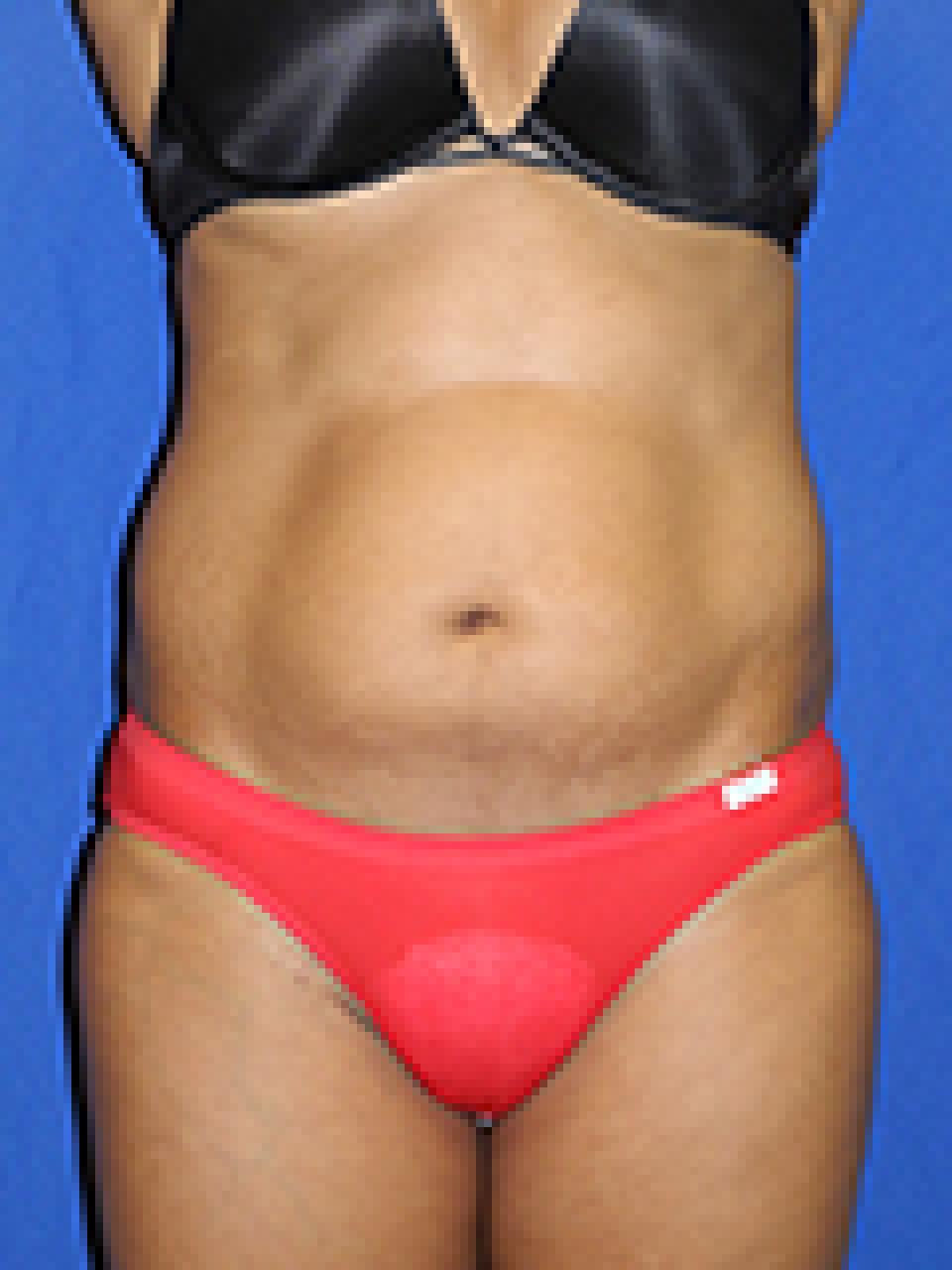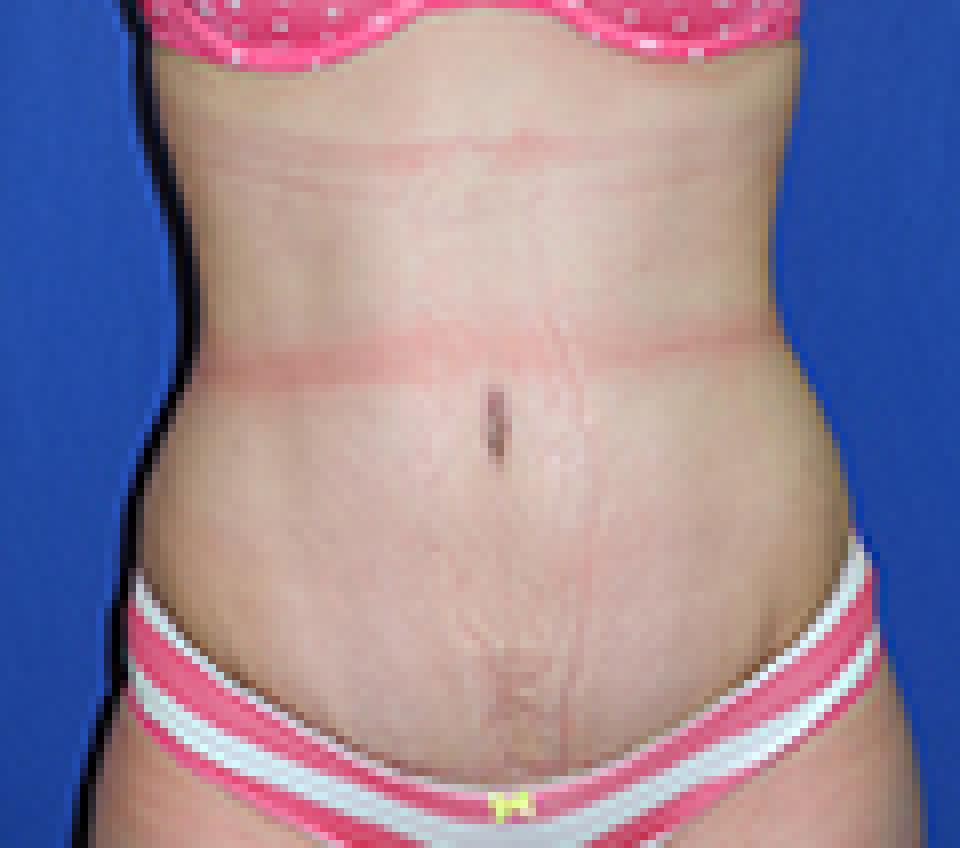Abdominal Musculature
Stretching from the ribs on each side, down to the margins of the pelvis, the abdominal contents are protected and retained in place by a dense layer of fibrous tissue, the abdominal fascia, which is effectively also a broad tendon, called aponeurosis. Into this fascia, and forming the aponeurosis, are inserted several muscles, but the specific names of the muscles should not detract from the importance of the fascia.
Visually prominent, and known to the body conscious public as a “6-pack” are the longitudinal centrally placed rectus abdominis muscles. These muscles are attached to the crest of the pubis inferiorly and to the 5th, 6th, & 7th costal cartilages above; they are encased in an envelope of deep fascia or aponeurosis (deficient posteriorly in the lower abdomen). The space between them is formed by the fascia and termed linea alba; there are transverse tendinous intersections which divide the muscle apparently into its 6 components.
The external oblique muscle has its upper bony attachment to ribs 4-12, its multiple slips fuse into a single sheet of muscle as they sweep downwards and forward to fuse into the aponeurosis that forms the sheath around rectus abdominis; the lowermost muscle fibers insert into the iliac crest of the pelvis and along its upper margin at the pubis.
The internal oblique muscle lies deep to the external oblique; its fibers run in what seems to be the opposite direction, from the lowest three ribs and crest of the pelvis, upwards and inwards to form part of the aponeurosis around the rectus muscle.
The transversus abdominis is attached posteriorly to the dense lumbar fascia, the muscle fibers run transversely around the side of the abdomen to join the aponeurosis that forms the posterior aspect of the rectus sheath.
 before
before
 after
after
This is a 32 year old woman with a BMI of 24 who underwent mid-body liposuction using ultrasound assisted liposuction. She had borne one child and had a few stretch marks over her anterior abdomen. Typically, such patients are better candidates for an abdominoplasty, but this woman's skin elasticity was fairly intact and her abominal wall muscles had not been overly stretched by the pregnancy either. She very much wished to avoid any scarring over her abdomen. She and I were both willing to accept a minor amount of skin looseness and so after much discussion, I proceeded with ultrasound assisted liposuction of her entire trunk, front and back.
Her result shows a significant improvement with which she is quite pleased. Other individuals who wished to have "tight" skin would achieve an exceptional result with a lipoabdominoplasty, which would entail an 10 to 12 inch long scar in the lower abdomen.
 before
before
 after
after
This 33 year old woman embarked upon a diet and exercise program that resulted in a 100 pounds weight loss over a 10 month period. Significant changes in her body's appearance occured, but because there is a limit to how much an individual's skin can shrink down to a smaller contour, some issues remained.
These types of issues are ideally adressed by performing an abdominoplasty along with tailored liposuction.
 before
before
 after
after
This is a 21 year old woman with a BMI of 25.5 who had borne one child and became very displeased with the contour of her abdomen as a result. She had already been told that she had an umbilical hernia and wished to undergo repair of both issues at the same time.
She underwent lipoabdominoplasty, a procedure that treats the front of the abdomen by safely combining liposuction and abdominoplasty, along with liposuction of the bilateral anterior flanks, which refers to the front half of the "sides" of the body. Her umbilical hernia was repaired at the same time by Scott Belsley, MD, FACS, a board certified general surgeon, using a biological mesh that is incorporated into the body's own tissues over time. Dr. Scott Belsley and I often collaborate on cases that involve both plastic surgical and general surgical issues.
 before
before
 after
after
This case depicts a 51 year old woman who was delivered of two children by c-section. Both her abdominal skin and abdominal wall had been stretched during her pregnancy, giving her abdomen a less taught appearance. These post-partum changes are not typically response to diet or exercise.
Although abdominoplasty incisions can vary in length, a portion can be placed within an existing transverse c-section scar. Often, the entire incision is relatively easy to hide, even when wearing a two piece swimsuit. The post-operative photographs depict this woman's appearance approximately one year after surgery.
 before
before
 after
after
This case depicts a 37 year old woman who had borne a child and noticed several changes in the appearance of her abdomen post-partum. Her abdominal skin appeared to be sagging, her abdominal wall was less taught than it had been prior to her pregnancy and she had developed significant stretch marks.
Individuals such as this woman are optimal candidates for an abdominoplasty or "tummy tuck," as they have "stretched out" skin that would not respond well to liposuction. The post-operative photographs depict this woman's appearance approximately one year after surgery.
 before
before
 after
after
This case depicts a 44 year old woman who had borne four children and was most concerned with excess skin, which was severely affected with stretch marks, on her abdomen. Such individuals are optimal candidates for an abdominoplasty or "tummy tuck." While many of the stretch marks can be removed during this surgery, even those that remain are less noticeable when the skin is taught. An abdominoplasty is also designed to tighten the abdominal musculature, which may also be stretched or malpositioned as a result of pregnancy.
The post-operative photographs depict this woman's appearance approximately one month after surgery.
 before
before
 after
after
This case depicts a 29 year old woman who after bearing three children had become concerned with the protuberance of her abdomen. In this case, both stretching of the abdominal wall and excess fat beneath the abdominal skin were contributing to the unfavorable contour of her abdomen.
She had moderate but not severe stretch marks over her abdomen, the majority of which were removed in the surgery.
 before
before
 after
after
This case depicts a 40 year old woman who had borne three children via c-section. Her c-section resulted in a vertical scar starting immediately below the belly button or umbilicus. She had extra fat beneath the abdominal skin, in addition to a noticeable c-section scar.
During her surgery, the abdominal wall was tightened, portions of the excess fat beneath the skin were removed and the entire vertical c-section scar was removed. The post-operative photographs depict this woman's appearance approximately one month after surgery.
 before
before
 after
after
This 25 year old woman with a preoperative BMI of 31.8 underwent abdominoplasty along with circumferential liposuction. This procedure treats the trunk or mid-section of the body as one unit all the way around. I believe that this method results in a more harmonious result than treating just the front with an abdominoplasty or just the back with liposuction.
In my practice, I tend to use ultrasound assisted liposuction to perform liposuction of the back, because I feel that in my hands, this technique allows me to remove more fat, more thoroughly than other forms of liposuction.
I try to keep the lower abdominal scar low enough such that it is not difficult to find a number of swimsuit choices will cover it without difficulty and also as short as possible- usually less than 12 inches in length.